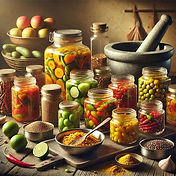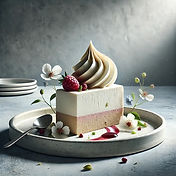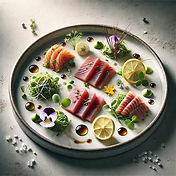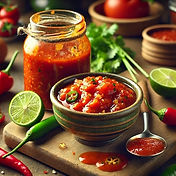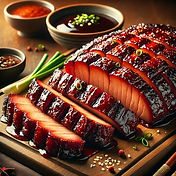Top Chef ™: World All-Stars
Season:
Week:
Elimination Challenge

Padma Lakshi: "Pack your bags, because our friends at VRBO are sending you on a holiday of your own in the countryside of Kent, also known as the garden of England, where you'll have a whole vacation home to enjoy. There, you'll get to put on a celebration for your new Top Chef ™ family, each other, and of course, the judges. We're in the family too. Now, tonight, you'll head to your vacation home, and tomorrow you'll each be responsible for a dish inspired by your favorite holiday. We expect a family holiday feast. So you guys will have to work together to give us a complete holiday table. Just like every family, you have a shared family budget of £1000 spend at Whole Foods Market."
Dishes prepared in
Top Chef ™: World All-Stars
Chef Charbel: "This is called Eggplant Fatteh. In Christmas, all the family gathered together, and my grandma used to make the dish, and I couldn't wait to eat it. In the bottom is tomato and onion concasee. Second layer going to be fried eggplant with yogurt and tahini. On top is crispy pita, fresh herbs, and pomegranate."
Chef Victoire: " I'm making madesu, my national dish. Today. I have to cook the beans to make the stew. During Christmas, we usually cook black eyed beans because they represent prosperity. "
Chef Victoire: "Madesu is a simple stew with bean, tomato, onion and some spices. This stew, we make it when we want to wish a best life. And this sauce goes with it. The green sauce on the top, it will with black beans.
Chef Nicole: "I'm making a five spice pork belly. This is something we eat on Chinese New Year."
Chef Nicole: "This is a riff on traditional Chinese New Year's pork belly. It's five spice scented in a master stock. So I just did a sous vide version of it, roasted."
Padma Lakshi: "Nicole, this is delicious."
Chef Sara: "The first time that my mother ever took my father home to meet the family, my grandfather asked my dad to come out in the yard and help cut down a tree. He cut through the tree and then the back of my father's leg. My mother was, like, inside trying to cook this beautiful spinach souffle. It stayed in the oven, while they were at the hospital. And they came home and they thought it was absolutely delicious. So it's tradition in our family to have really over-cooked creamed greens, and then it's got brisket gravy.
Chef Amar: "I'm doing a Moroccan style braised lamb shank with a lot of saffron and turmeric."
Chef Begona: "Why Moroccan?"
Chef Amar: "I love the food there. I love the culture. The lamb is very savory, but then it's covered with this beautiful sweet onion cinnamon prune marmalade. It's like flavor bomb."
Chef Amar: "So I'm from the Dominican Republic, and we never eat savory with sweet. So the first time I went to Morocco on vacation, this was the first dish that was sitting at the table with the braised lamb shank with prunes, cinnamon, sweet onions on top, toasted almonds."
Chef Ali: "I'm making Mashawi, which is a little like the American mixed grill. The name comes from Eid-al-Adha. Back home, my family and I, we just gather in our garden and we make barbecue, because Eid-al-Adha ... it's more about sacrificing what you have to give it to the poor. It's like sharing your food."
Chef Ali: "Today I have prepared flat bread, lamb kebab, shish kebab. And on the side I have prepared mezze style dishes. Tartar sauce with pomegranate molasses. This reminds me of Eid al Adha when we go and buy lamb, sheep, cow or camel. And then we slaughter it. And you're only allowed to take one third of the whole animal and the rest you give away to people in need.
Chef Tom: " I born and raised on a small winery. I grew up between a lot of animals and wine. When you finish your harvest seasoning in the winery and you collect the last grapes, you vote for the flavor of the cake for that day. And that's something which really connects me with my family, and I love it. So I got to make that cake."
Chef Tom: " Because I'm born and raised on a little winery, you vote to choose the fruit of the cake for the night. And then all the grandmothers, they make a cake only out of this ingredient, plus another fruit for the sauce. So the cake is actually an apple cake. It has pastry cream on it, apple sauce on it, honey, chantilly chocolate sponges. And on the side, we have the hot plums.
Chef Gabri: "I'm making this Mole Verde in celebration of my dad."
Chef Gabri: "I made sea bass with mole verde and pickled onions with radish and french blue corn tortillas. This celebration is for the Dia de los Muertos. I just made it for my dad who actually passed away last year."
Chef Sylwia: "I'm doing the traditional Polish soup. I'm adding the horseradish, double cream and a sour cream. So it's a little bit sour. I love it. When I sit down over this soup with my family, it's very important for us."
Chef Sylwia: "This is polish borscht full of pork, and Polish sausage. And of course, it must be full of potatoes and carrots. We finish that with fresh cooked radish and garlic. And we always eat that with hard boiled egg alongside."
Chef Buddha: "So I'm making the dish inspired by salmon tarator with pomegranate, molasses, yogurt and nuts. I'll make this dish every Christmas. I don't really have a lot of traditions in Christmas. I only started about four or five years ago. Growing up in my family's restaurant, we always worked on Christmas. We didn't really celebrate it, but my wife Rebecca, their family, they have a huge Christmas."
Chef Buddha: " This is a middle eastern dish. That I would cook every Christmas. Salmon tarator. It's a salmon that's been baked. You then smear tahini, yogurt, couscous, sumac, chili, salted lemon, walnuts, pine nuts, fresh grapes."
Chef Begona: "The days after Christmas is when I meet my friends or the people that I really want to be with. We have the leftovers and then we do a nice sauce to put over for me. Special. I'm turning that into my vacation dish."
Chef Begona: "We always cook a stew with chicken inside and stuff. This version has chicken, vegetables, and peanut sauce."
Culinary Challenges inspired by
Top Chef ™: World All-Stars
Tsukune are Japanese chicken meatballs, popular in yakitori restaurants and izakayas.
These juicy meatballs combine ground chicken with finely chopped onions, ginger, and sometimes shiitake mushrooms. The mixture is typically seasoned with soy sauce, sake, and mirin, then shaped around skewers before grilling.
What makes tsukune distinctive is their texture—slightly bouncy yet tender—achieved by kneading the mixture until sticky. They're typically glazed with tare (a sweet-savory sauce) during grilling for a caramelized finish.
Home cooks can bake them instead of grilling and adjust the seasonings to taste. For authentic texture, include cartilage or use chicken thigh meat with its natural fat. Serve tsukune hot, brushed with additional tare and optionally topped with a sprinkle of sansho pepper.
Togarashi (Japanese for "chili pepper") commonly refers to shichimi togarashi, a seven-spice blend featuring chili peppers, orange peel, sesame seeds, nori, ginger, sansho pepper, and hemp seeds. This versatile condiment adds heat, umami, and complexity to noodles, rice, grilled meats, and vegetables.
Store togarashi in an airtight container away from light and heat. For freshest flavor, purchase small amounts or make your own by toasting and mixing the ingredients to your preferred balance of heat and flavor.
A "fennel pollen togarashi" variation could substitute fennel pollen for traditional nori, creating a unique blend with delicate anise notes that pairs exceptionally well with seafood, especially grilled fish. This fusion version would bring Mediterranean floral sweetness to the traditional Japanese spice profile.
Achar is a popular South Asian condiment, consisting of pickled fruits or vegetables preserved in oil, vinegar, and spices. This tangy, spicy relish adds bold flavor to meals across India, Pakistan, Nepal, and Bangladesh. Common varieties include mango (aam), lime (nimbu), and mixed vegetable achar.
The pickling process traditionally involves sun-drying ingredients before mixing with mustard oil and spice blends that typically include fenugreek, fennel, mustard seeds, and asafoetida. Achar serves as an essential accompaniment to everyday meals, providing contrasting flavors that enhance rice, bread, curries, and other dishes.
Making Ice Cream with Liquid Nitrogen
Liquid nitrogen ice cream offers home cooks a spectacular culinary adventure, creating the smoothest, creamiest frozen dessert possible. At -320°F, liquid nitrogen flash-freezes ice cream base instantly, preventing large ice crystals from forming—the secret to its extraordinarily silky texture.
The process is surprisingly straightforward: prepare your favorite ice cream base (typically cream, milk, sugar, and flavorings), then slowly pour liquid nitrogen into the mixture while continuously stirring. The dramatic plume of fog that billows out creates an impressive kitchen spectacle as your cream transforms into ice cream within minutes.
Safety precautions are absolutely essential. Always use insulated gloves, protective eyewear, and work in a well-ventilated area. Use metal or wooden mixing bowls—never glass, which could shatter. Always keep the liquid nitrogen container in an upright position and never seal it in a closed container.
While not an everyday technique, liquid nitrogen ice cream makes for a memorable cooking demonstration or special occasion dessert. The rapid freezing preserves flavors exceptionally well, allowing delicate notes to shine through that might otherwise be lost in traditional churning methods. For the culinary adventurer, it's a fascinating intersection of food science and dessert artistry that creates an unforgettable dining experience.
Ceviche Jipijapa is a distinctive Ecuadorian seafood dish hailing from the coastal town of Jipijapa in Manabí province. This regional specialty transforms fresh fish (typically corvina or sea bass) by "cooking" it in citrus juice—traditionally a mixture of bitter orange and lime. What sets Jipijapa ceviche apart is its characteristic creamy texture achieved through the addition of peanut butter or ground peanuts.
The dish combines the citrus-marinated fish with finely diced tomatoes, red onions, cilantro, and the crucial peanut element, creating a harmonious balance of bright acidity, oceanic freshness, and nutty richness. Often served with chifles (plantain chips), toasted corn, or popcorn for textural contrast,
Ceviche Jipijapa represents the indigenious coastal cuisine of Ecuador that celebrates local ingredients and flavors.
Sea buckthorn berries offer a truly unique flavor experience that's difficult to compare to more common fruits. They deliver an intensely tart and acidic profile with bright citrus notes reminiscent of passionfruit, orange, and pineapple. This vibrant acidity is balanced by an underlying sweetness and distinctive tropical character.
What makes sea buckthorn particularly interesting is its complex finish—slightly astringent with a subtle pine-like quality that hints at its northern climate origins. The berries contain natural oils that create a creamy mouthfeel unlike most other fruits.
The powerful tanginess makes pure sea buckthorn challenging to eat raw, which is why it's often found in juices, sauces, and preserves where sweeteners can balance its intensity. Chefs prize sea buckthorn for its vivid orange color and ability to add a surprising burst of sunshine-like acidity to both sweet and savory dishes.
Semifreddo is an elegant Italian frozen dessert whose name aptly translates to "half-cold" or "half-frozen." Unlike traditional ice cream, semifreddo achieves its luxurious texture through a masterful combination of whipped cream, beaten egg yolks, and whipped egg whites, creating a velvety mousse that's frozen until just set.
What makes semifreddo truly exceptional is its remarkably light, airy texture that melts effortlessly on the tongue. Without requiring an ice cream machine, home cooks can create this sophisticated dessert with basic kitchen equipment. Semifreddo holds its shape beautifully when sliced, creating impressive presentations with clean, defined layers when flavored differently.
The dessert's versatility is another standout feature—it welcomes countless flavor variations from fruit purées and chocolate to nuts and coffee. Semifreddo also maintains a perfectly soft consistency straight from the freezer, eliminating the wait time needed for traditional ice cream to soften.
Crudo is an elegant Italian preparation of raw fish or seafood that celebrates the pure, delicate flavors of fresh ingredients. Similar to sashimi but with Mediterranean flair, crudo features paper-thin slices of high-quality raw fish dressed simply with excellent olive oil, citrus juice (often lemon), sea salt, and sometimes herbs or spices.
The key to exceptional crudo lies in impeccably fresh seafood—look for fish labeled "sushi-grade" or visit a trusted fishmonger. Slice the fish against the grain while it's still cold, then dress it just before serving. The acidity from the citrus gently "cooks" the proteins, resulting in a silky texture and bright flavor that pairs beautifully with the richness of olive oil.
Ecuadorian aji casero is a vibrant, freshly prepared hot sauce that's a staple condiment in Ecuador's cuisine. This zesty sauce combines the heat of fresh hot peppers (typically tree chilis or aji criollo) with the brightness of lime juice, the crunch of finely diced red onions, and the freshness of cilantro.
To make aji casero, the peppers are minced and combined with diced onions, chopped cilantro, lime juice, and a splash of water.
Some versions incorporate tomatoes or even a touch of orange juice for sweetness. The ingredients are mixed together and allowed to sit briefly, letting the flavors meld. This versatile sauce brightens everything from empanadas and llapingachos to soups and grilled meats.
Char siu is a beloved Cantonese barbecued pork dish known for its distinctive red hue and sweet-savory glaze. This iconic preparation features pork shoulder or belly marinated in a fragrant mixture of five-spice powder, hoisin sauce, soy sauce, honey, and red fermented bean curd (which gives it that signature color).
To make char siu, the marinated meat is traditionally hung on hooks and roasted in a special oven, allowing the fat to render while the exterior caramelizes to a glossy finish. The result is tender, juicy pork with a complex flavor profile – simultaneously sweet, savory, and slightly smoky. Often sliced and served with rice or added to noodle dishes, char siu is a versatile staple in Chinese cuisine.
Pikliz is a vibrant Haitian condiment that brings a spicy, tangy kick to any dish it accompanies. This colorful slaw combines shredded cabbage, carrots, bell peppers, and onions, all marinated in a fiery mixture of vinegar, lime juice, and Scotch bonnet or habanero peppers.
To make pikliz, vegetables are thinly sliced or shredded, often with a mandoline, then packed in jars with the acidic mixture and allowed to pickle for at least 24 hours, although many Haitians let it ferment for days or even weeks, developing deeper flavors. The result is a crunchy, intensely flavorful condiment that's essential to Haitian cuisine, perfectly complementing rich dishes like griot (fried pork) or fried plantains.
There is our recipe for Pikliz here.
Ajika is a vibrant, aromatic spice blend originating from the Caucasus region, particularly Georgia and Abkhazia. This fiery condiment combines the heat of red chili peppers with aromatic herbs like fenugreek, coriander, and dried mint, along with garlic and walnuts for richness and depth. Traditional ajika is prepared by grinding dried chilies with fresh herbs, garlic, salt, and sometimes nuts into a coarse paste. The resulting blend offers an intense, complex flavor profile that's simultaneously spicy, herbaceous, and slightly tangy. Used as a marinade, condiment, or cooking ingredient, ajika adds bold character to meats, vegetables, and stews, bringing the distinctive flavors of the Caucasus to your kitchen.




